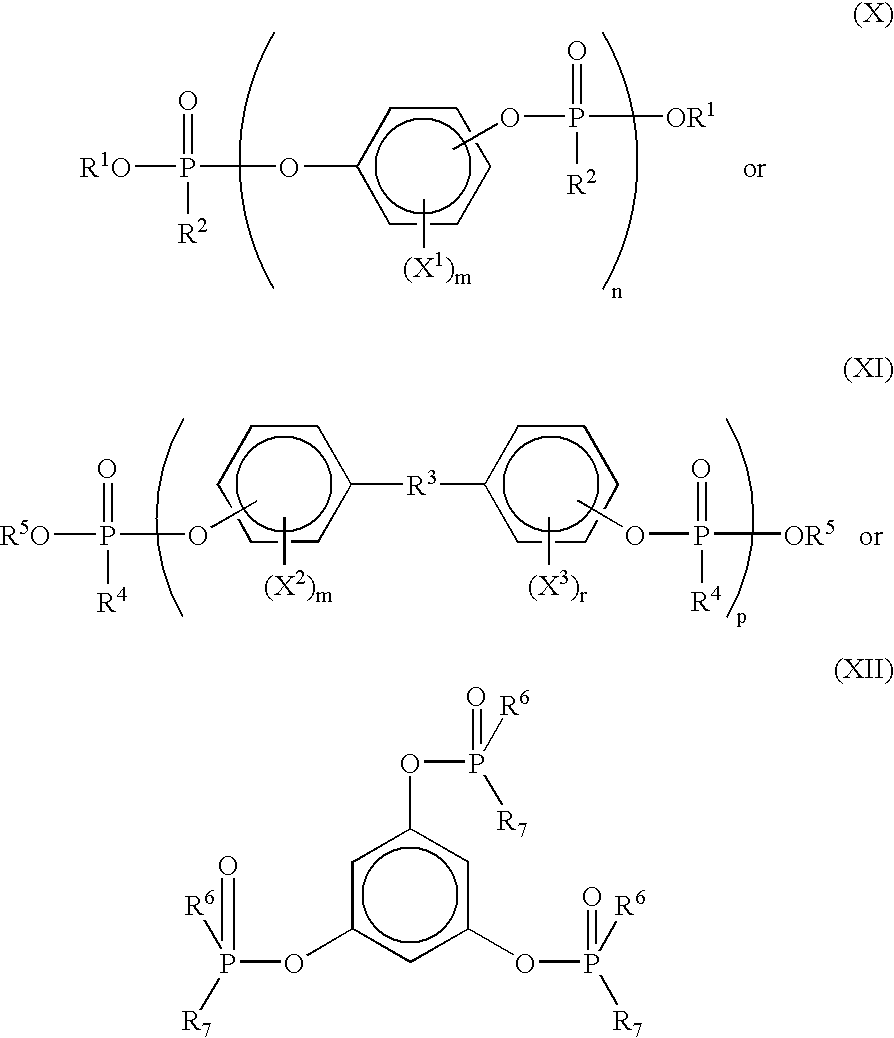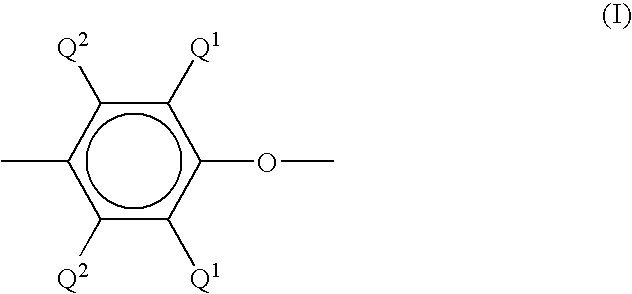Flame retardant composition
a composition and flame retardant technology, applied in the direction of group 5/15 element organic compounds, electrical appliances, textiles and paper, etc., can solve the problems of high-flammability compositions, objectionable physical properties, plate-out and migration, etc., and achieve the effect of little or no negative impact on the physical properties of thermoplastic compositions
- Summary
- Abstract
- Description
- Claims
- Application Information
AI Technical Summary
Benefits of technology
Problems solved by technology
Method used
Image
Examples
examples
[0092] The following examples employed the materials listed in Table 1. All weight percents employed in the examples are based on the weight of the entire composition except where stated.
TABLE 1ComponentDescription / SupplierPPEPoly(phenylene ether) having anintrinsic viscosity of 0.46 g / dl whenmeasure in chloroform at 25° C.SEBS IPolystyrene-poly(ethylene-butylene)-polystyrene having a polystyrenecontent of 13 weight percent that iscommercially available from KratonPolymers Ltd under the tradenameKraton G1657.SEBS IIPolystyrene-poly(ethylene-butylene)-polystyrene having a polystyrenecontent of 30 weight percent that iscommercially available from KratonPolymers Ltd under the tradenameKraton G1650.SEBS IIIPolystyrene-poly(ethylene-butylene-styrene)-polystyrene having 39%polystyrene content and commerciallyavailable from Kraton Polymers Ltdunder the tradename Kraton A, gradeRP 6936.SEBS IVPolystyrene-poly(ethylene-butylene)-polystyrene having a polystyrenecontent of 30 weight percent ...
examples 1-9
[0093] A thermoplastic composition containing 38.5 weight percent PPE, 26.9 weight percent SEBS I, 25.6 weight percent LLDPE and 9.0 weight percent polybutene, based on the total weight of thermoplastics was melt mixed with RDP, MPP, and Mg(OH)2 in the amounts shown in Table 2. The amounts of RDP, MPP and Mg(OH)2 amounts are shown in parts per hundred parts of thermoplastic composition (PPE+SEBS I+LLDPE+polybutene). The composition was molded into 3.2 millimeter bars for flammability testing. Flammability tests were performed following the procedure of Underwriter's Laboratory Bulletin 94 entitled “Tests for Flammability of Plastic Materials, UL94”. Each bar that extinguished was ignited twice. According to this procedure, the materials were classified as either HB, V0, V1 or V2 on the basis of the test results obtained for five samples. The criteria for each of these flammability classifications according to UL94, are, briefly, as follows.
[0094] HB: In a 5 inch sample, placed so t...
examples 10-15
[0100] A thermoplastic composition containing 42.6 weight percent PPE, 32.0 weight percent SEBS I, 21.4 weight percent LLDPE and 4.0 weight percent polybutene, based on the total weight of thermoplastics, was melt mixed with BTPP, RDP, MPP, and Mg(OH)2 in the amounts shown in Table 3. BTPP, RDP, MPP, and Mg(OH)2 amounts are in parts per hundred parts of thermoplastic composition (PPE+SEBS I+LLDPE+polybutene). The composition was molded into 3.2 millimeter bars for flammability testing and tested as described in Examples 1-9.
TABLE 3UL94ExampleBTPPRDPMPPMg(OH)2Burn timerating103.919.311.47.75.2V011019.311.47.717.4V112024.412.87.72.9V013025.77.77.71.9V0146.419.311.411.424.2V11510.315.47.710.38.8V0
[0101] Examples 10-15 demonstrate that combinations of organic phosphate are useful in the flame retardant additive composition and that excellent flame retardance (V1 and V0) can be achieved with the fire retardant additive composition.
PUM
| Property | Measurement | Unit |
|---|---|---|
| Percent by mass | aaaaa | aaaaa |
| Percent by mass | aaaaa | aaaaa |
| Percent by mass | aaaaa | aaaaa |
Abstract
Description
Claims
Application Information
 Login to View More
Login to View More - R&D
- Intellectual Property
- Life Sciences
- Materials
- Tech Scout
- Unparalleled Data Quality
- Higher Quality Content
- 60% Fewer Hallucinations
Browse by: Latest US Patents, China's latest patents, Technical Efficacy Thesaurus, Application Domain, Technology Topic, Popular Technical Reports.
© 2025 PatSnap. All rights reserved.Legal|Privacy policy|Modern Slavery Act Transparency Statement|Sitemap|About US| Contact US: help@patsnap.com



